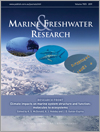Marine and Freshwater Research
Volume 70
Number 1 2019
RESEARCH FRONT: Climate Impacts on Marine System Structure and Function: Molecules to Ecosystems
In this introduction to the research front, ‘Climate impacts on marine system structure and function: molecules to ecosystems’, a review of climate change coverage in the media since 1980 showed that climate change science had a substantial voice globally and, in particular, in countries with carbon-dependent economies. The integration of inter-disciplinary, multi-scale information, such as outlined in this research front, can result in more holistic climate change stories that scientists can effectively communicate with stakeholders and the broader community.
Tropical reefs are highly diverse ecosystems, and reliable biomonitoring, through genetic diet analysis (i.e. metabarcoding), is crucial to understand future interactions in the face of climate change. The metabarcoding success of different molecular marker genes has rarely been assessed in such ecosystems. This novel study showed that marker success for prey identification is highly dependent on the reference database, taxonomic scope, DNA quality, amplicon length and sequencing platform.
How baleen whales locate prey is not well understood. In the present study, biotelemetry devices provided information on humpback whale movement at two spatial scales in relation to environmental conditions in East Antarctica. Water temperature was correlated with a change in whale foraging behaviour at both scales, adding support to the hypothesis that baleen whales may be able to track environmental conditions to find prey.
Climate-driven shifts in species distributions are occurring rapidly and marine resource users require information relevant to their activities at decision-making timescales to adapt effectively. Temporal persistence of suitable oceanographic habitat for kingfish (Seriola lalandi) was assessed under near-future climate change for six coastal bioregions from south-eastern Australia, with a decline predicted for the northernmost (equatorward) bioregion and increases predicted for the three southernmost (poleward) bioregions. We suggest that temporal habitat persistence is an important metric for climate change adaptation because it provides information relevant to fishing and economic opportunity.
Lord Howe Island and Balls Pyramid are World Heritage-listed islands in the south-western Pacific that support coral reefs and communities occurring at their southernmost limits. Here, we explore deep coral communities discovered on the submerged platforms surrounding the islands to explore the distribution of deep corals in a subtropical setting, of which there are few studies globally.
Recent years have seen considerable research effort devoted to understanding Australian marine climate-change impacts and adaptation. Literature analysis indicated that a structured, national-level program underpinned by strong stakeholder engagement is beneficial for rapidly addressing key climate-change questions and adaptation needs across fisheries, aquaculture, conservation and tourism sectors. Additional effort is still needed with regard to adaptation research.
We synthesise the collective experience of the authors to explore progress in integrating natural and social sciences in marine ecosystem-based management research. We find that integration has progressed; however, practitioners do not yet have the capacity to address many of the problems we face. Consequently, we also assess how to support the next generation of researchers to undertake inter-disciplinary research, particularly in a changing climate.
Life history parameters are essential to understanding the resilience of species to fishing activities. In this study we provide the first growth parameter estimates for the Rio skate Rioraja agassizii, a threatened endemic skate species in the western South Atlantic. We found that Rio skate has moderate growth (k = 0.27 and 0.22 cm year–1 for males and females respectively), which may make this species more vulnerable to the fishing pressure from the trawling fleet operating in the area.
Rhinoptera steindachneri is a resource that is frequently captured in north-western Mexico. Its reproductive biology was investigated in this study on the basis of 317 specimens caught in Bahía de la Paz, Mexico. For females, the median size at maturity was 71.8-cm disc width, fecundity was one embryo per female and there was a continuous and synchronous annual reproductive cycle.
We investigated the stock structure of Sperata aor inhabiting River Ganga. Significant morphological variations were found among the selected sampling locations for the target fish species. Cross-validation classification showed 87.5% correct classification of individuals to their original populations. The findings from the present study can be utilised to efficiently manage the S. aor stocks in River Ganga.
Analysis of data from more than 20 000 New Zealand river sites sampled over the past 47 years revealed marked declines in freshwater fish populations. In the 1990s, one-quarter of the native species were listed as ‘in decline’ or ‘threatened’ (with extinction), but by 2013 this had risen to three-quarters; this is among the worst records globally. The present analysis revealed that the declines were clearly related to changes in land cover and land use, particularly in catchments in pastoral farming areas.
A partnership between Yolŋu and Western scientists investigated the dieback of culturally significant coastal Melaleuca (paperbark) in the Laynhapuy Indigenous Protected Area (IPA). Each knowledge system suggested that climate-driven sea level rise and feral buffalo and pig explained ~70% of forest decline. This is the first cross-cultural and on-ground study of Melaleuca forest dieback in northern Australia. Results will inform IPA management.
Improving our understanding of fish use of saltmarshes could raise much needed public awareness and material support for saltmarsh rehabilitation. In all, 851 fish from 11 species were caught at a mean density of >72 fish per 100 m2. The results suggest that restoring basic saltmarsh structure through tidal reconnection will deliver benefits for fish productivity through habitat expansion.





